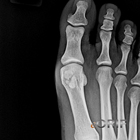 |
synonyms: sesamoid pain, sesamoid fracture, Ballet dancer, sesamoiditis Sesamoid ICD-10
Sesamoid Etiology / Epidemiology / Natural History
Sesamoid Xray / Diagnositc Tests
Sesamoid Classification / Treatment
Sesamoid Associated Injuries / Differential Diagnosis
|
